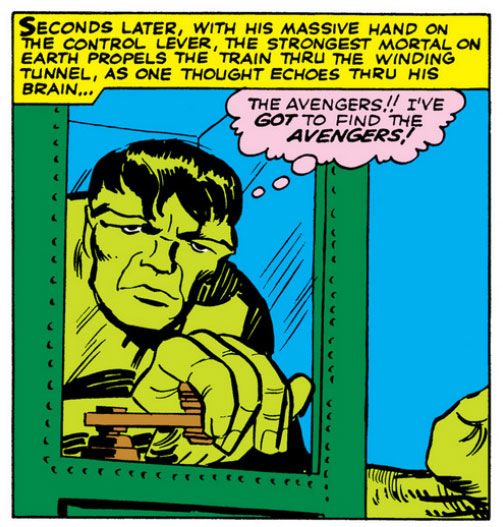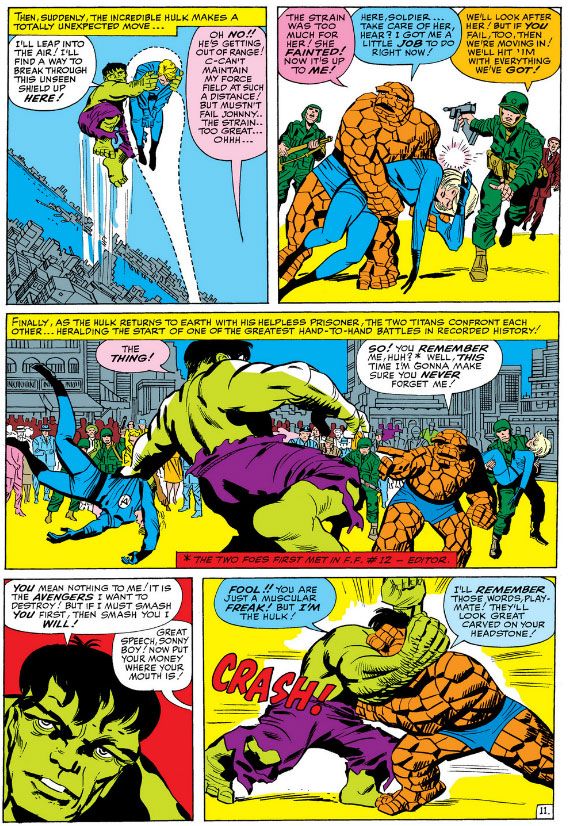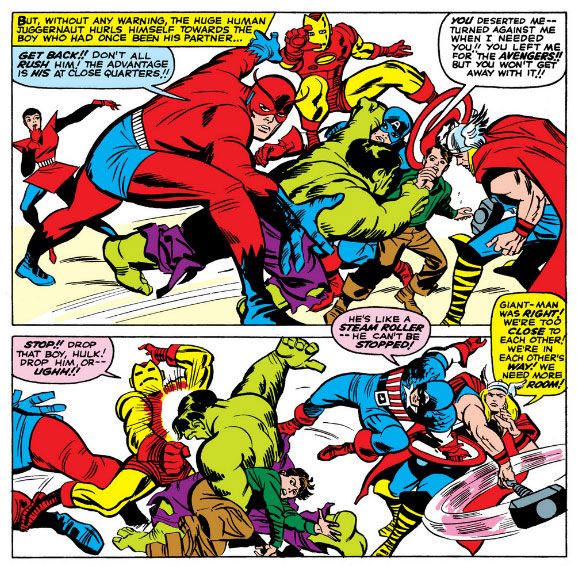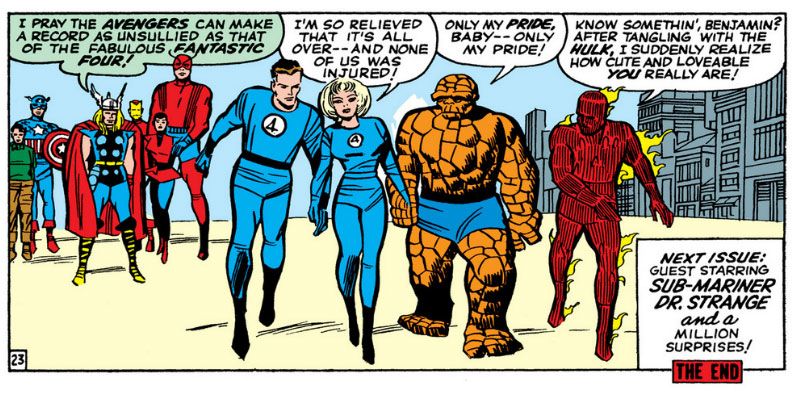First, you have the Thing. A mouthy orange rock-man, the muscle and the ever-lovin' heart of the Fantastic Four. The Thing was essentially nice. Who the heck could hate the Thing? Then, you have the Hulk. In the 1960s, at least for a time, the Hulk had a command of language beyond simple statements in favor of smashing, or admonishments to puny humans to leave him alone. He was an anti-hero hearkening back to Marvel's early years when they put out comics where Namor would show up pissed off for whatever reason and start tearing up the place. Namor was the kind of dangerous character you rooted for only because he was fighting Nazis (only other Nazis root for Nazis), mad scientists or because he was like your own repressed child-id striking back at adult authority figures-- otherwise, Namor was angry specifically at you, the reader, for existing on land. It's a similar story with the Hulk and Space Age-era Communists and outright villains.
 With two opposing forces like these in a single comic book universe, it was only a matter of time before they clashed. And clash they did in Fantastic Four #12 (March 1963) by Stan Lee, Jack Kirby and inks by Dick Ayers, from those fabled days when Kirby hadn't yet settled on the correct number of fingers and toes for the Hulk. In this issue, the Jade Giant flaunts three of each, plus opposable thumbs for a grand total of fourteen digits. Strangely enough, the same number sported by the Thing. That's okay, because there's at least one instance of Mr. Fantastic showing six on one hand in a later issue.
With two opposing forces like these in a single comic book universe, it was only a matter of time before they clashed. And clash they did in Fantastic Four #12 (March 1963) by Stan Lee, Jack Kirby and inks by Dick Ayers, from those fabled days when Kirby hadn't yet settled on the correct number of fingers and toes for the Hulk. In this issue, the Jade Giant flaunts three of each, plus opposable thumbs for a grand total of fourteen digits. Strangely enough, the same number sported by the Thing. That's okay, because there's at least one instance of Mr. Fantastic showing six on one hand in a later issue.The story opens with the Thing looking natty in a tux, out on the town with his girlfriend Alicia Masters. Within moments, things take a tragi-comic turn as they frequently do in this old Marvel stories-- soldiers on the alert for the Hulk cause a scene, an old man accidentally pokes the Thing, the Thing reacts angrily, attracts the attention of the soldiers, there's a fight as a result of mistaken identity and the Thing is publicly humiliated once again. Why the soldiers are out looking for the Hulk is obvious-- he's a destructive menace. But why their officers sent them out without first briefing them on what the Hulk's actual appearance is something neither Stan Lee nor Jack Kirby care to explain. And if being mistaken for a green monster in purple pants isn't pathetic enough for our orange monster in blue pants, the Thing also forgets his key to the Fantastic Four's special elevator and has to climb up the cables to get home.
None other than General "Thunderbolt" Ross (oddly appearing in an army uniform rather than one from the USAF) then comes to the Baxter Building to recruit the team to fight the Hulk for him. To prove the Hulk's existence, Ross screens some top secret film footage of the Hulk in action, which causes the testosterone-laden male heroes-- including ostensibly mature older genius Reed Richards-- to act out their fantasies of single-handedly defeating the Hulk, while lone female Sue Storm frets about her uselessness. At least until the men decide she's good "for morale." Guess the Thing isn't the only one meeting with humiliation this fine evening.
 The issue features the debut of a new whiz-wagon for the gang, the Fantasticar redesigned in-story by Johnny Storm, and featuring one of the many meta-moments Lee and Kirby inserted into the book in those days-- supposedly fans of the team wrote in complaining that the old Fantasticar looked too much like a flying bathtub. The new one is a sleek Kirby creation that gives Ross a military-industrial complex boner. The five rocket to the western desert and fight's on.
The issue features the debut of a new whiz-wagon for the gang, the Fantasticar redesigned in-story by Johnny Storm, and featuring one of the many meta-moments Lee and Kirby inserted into the book in those days-- supposedly fans of the team wrote in complaining that the old Fantasticar looked too much like a flying bathtub. The new one is a sleek Kirby creation that gives Ross a military-industrial complex boner. The five rocket to the western desert and fight's on. The Hulk is actually a big green herring as it turns out-- the real villain is someone called "the Wrecker" (a likely name) who sabotages our American way of life for his Commie overlords. I don't want to spoil the story's big secret, but the Wrecker turns out to be the guy with the membership card in a communist subversive organization right there in his wallet. Great detective work there, Rick Jones. This leaves the Thing wondering out loud, "Just what the heck was I fighting the Hulk for?" No reason, really, other then the very coolness of Thing versus Hulk, Thing! Oh, and advertising for another hero even if his own title flopped. In their first bout, our boys seem pretty evenly matched, and it's useless Sue Storm who manages to knock out the Wrecker and save the day for everyone. Never underestimate Sue, fellas. The Hulk, weakened by a laser beam, gives up and slinks away to fight another day. So after all that, we don't even get a definitive answer to the question of which hero is muscle supreme in the Marvel universe.
That is until a year later when Marvel published Fantastic Four #25 and 26 (April and May 1964 with George Roussos on inks this time, credited as George Bell), a story so big it sprawls over two complete issues and involves practically every other Marvel hero of the time. I'm guessing it was Lee who crammed all the hyperbolic copy onto the cover of #25, the Man at his carnival barker's best. This is the kind of stuff I've come to associate with the feeling of reading Marvel comics from the 60s and 70s-- a relentless barrage of overblown propaganda, indoctrinating the readers in the Mighty Marvel Mindset with phrases like "PULSE-POUNDING" and "SENSES-SHATTERING" (as if the latter was even remotely desirable). This time the Fantastic Four don't have to go hunting the Hulk-- the big green galoot himself turns up in New York City because he's angry at the Avengers for booting him in favor of Captain America.
I can't blame the Avengers. Who would you rather have on your team anyway-- a rational, intelligent strategist with acrobatic fighting skills and years of war-time experience, or an overly-sensitive rage-aholic with the strength to flatten entire cities? No, you can't choose both. Now imagine how well the Hulk takes your decision and you can see the problem this dilemma presents. As if a vengeful Hulk weren't enough, the FF are fighting amongst themselves as well because the Thing refuses to drink Reed's newest cure for his condition-- which apparently was such a lab accident Reed doubts he can re-create it. Shortly after that, Reed abruptly collapses into a coma and everyone is screwed. The Hulk gives the remaining Fantastics a thorough thumping of the kind world champ Sonny Liston received from 22-year-old Muhammad Ali roughly a month before this issue hit the newsstands. The Human Torch ends up in the hospital and Sue poops out when the Hulk's strength severely taxes her relatively-new invisible forcefield powers. This leaves the Thing to fight alone, which he does for most of the issue until the Hulk finally grinds him down.
 Never having been defeated outright before, the Thing spends a moment questioning his purpose in the world. But he figures it out-- as a hero, his job is to take any beating necessary, even if he fails or dies as a result. Once again, it's the Thing doing the world's dirty work, overmatched and underappreciated, a lone man against impossible odds and, unlike Liston, he decides to come out of his corner at the bell.
Never having been defeated outright before, the Thing spends a moment questioning his purpose in the world. But he figures it out-- as a hero, his job is to take any beating necessary, even if he fails or dies as a result. Once again, it's the Thing doing the world's dirty work, overmatched and underappreciated, a lone man against impossible odds and, unlike Liston, he decides to come out of his corner at the bell. While poignantly scripted by Lee, this is Kirby storytelling, a moment where his contributions as a full-fledged writer-- not simply co-plotter and certainly not merely penciller-- breaks through most obviously. You can't help but feel Kirby working autobiographically here, concerns of an intensely personal nature filtering through the fat line screens of the 1960s four-color printing process. So characteristically Kirby is it, he'd return to it again and again-- most memorably in "The Death Wish of Terrible Turpin" from New Gods #8 (April 1972), but also as a running subtext to the entirety of his run on Kamandi the Last Boy on Earth.
Together, Lee and Kirby develop this theme over the course of #26, where we see Richards attempting to come off his sickbed to help the Thing and the Human Torch flying back into the fray despite being decked out in asbestos bandages from the beating he took in the previous issue. Captain America shows a lot of the heroic stuff Kirby-style as he uses judo he learned in the Army against the Hulk, even though he knows he's involved in a massive weight-class mismatch. So Captain America proves himself as an Avenger, but it's the Thing's example that inspires him and provides the story's beating heart.
 It's a fairly funny story as well, and I don't mean just inadvertently (for example, when the Hulk calls his weaker alter-ego "Bob" Banner for some reason-- we'll cut him some slack; he has a lot on his mind what with needing to file for unemployment and all that). At one point the Thing threatens to use his powers of pathos against the Hulk. My favorite sequence has the Hulk hijack a subway train and drive it to the Avengers' mansion. Kirby treats us to a sweet shot of a mopey Hulk at the controls which reminds me a lot of that Shaquille O'Neal commercial where he's too large for a sporty convertible. I'm pretty sure Lee and Kirby got a huge kick out of tossing in this particular scene.
It's a fairly funny story as well, and I don't mean just inadvertently (for example, when the Hulk calls his weaker alter-ego "Bob" Banner for some reason-- we'll cut him some slack; he has a lot on his mind what with needing to file for unemployment and all that). At one point the Thing threatens to use his powers of pathos against the Hulk. My favorite sequence has the Hulk hijack a subway train and drive it to the Avengers' mansion. Kirby treats us to a sweet shot of a mopey Hulk at the controls which reminds me a lot of that Shaquille O'Neal commercial where he's too large for a sporty convertible. I'm pretty sure Lee and Kirby got a huge kick out of tossing in this particular scene.Speaking of the Avengers, they finally make the scene and flub their fight against the Hulk because there are just too many costumed clowns running around. It gets worse when the fully recovered Fantastic Four pitch in, and then the two teams start a jurisdictional squabble. Reed Richards suggest the Thing decide whether or not the two teams join forces since he's the one who's been doing most of the fighting and carrying the story on his rocky shoulders.
 The Hulk and the Thing come together atop an under-construction building and trade blows. Teenager Rick Jones pulls a Sue Storm and saves the day by tossing a gamma pill into the Hulk's mouth. The Hulk falls into the river, but it's Bruce Banner its currents sweep away.
The Hulk and the Thing come together atop an under-construction building and trade blows. Teenager Rick Jones pulls a Sue Storm and saves the day by tossing a gamma pill into the Hulk's mouth. The Hulk falls into the river, but it's Bruce Banner its currents sweep away.Two complete issues probably seemed overblown in 1964, but in our current era of drawn-out, marketing-driven storytelling I'm amazed how economically Lee and Kirby run through this plot. Today's version would require an editor's meeting of a dozen or more thinkers to plan it (they'd spread it over an entire summer's or even a year's worth of titles priced at $2.99 or $3.99 each, interrupting whatever storylines the various writers have going), feature some supposedly-beloved secondary character like Rick Jones having his arms ripped off on-panel (the blog-o-sphere goes wild!) and climax in an over-sized special edition. Entertainment Weekly would give it a B+ and declare it "the superhero epic of the season" while praising it for the repeated flashbacks to Bruce Banner's abusive childhood. They'd also go nuts over the photo-realistic art, consisting mainly of pages of wide panels stacked broken by frequent full-body portraits of various involved characters, all of which would quickly show up in online auctions with hefty price-tags.
Lee and Kirby neatly pack it all into two standard-sized issues, minus any hint of gore but with plenty of action and characterization. It also lacks today's trendy Joss Whedon-style dialogue where every character is a quip-making machine, but apologizes by having the Thing call Thor a "lantern-jawed, long-haired lummox."
And yes, Sue, no one was injured. Except the Thing and your brother, Johnny (twice!). And probably Iron Man when the Hulk head-butted him right in the chest.






No comments:
Post a Comment